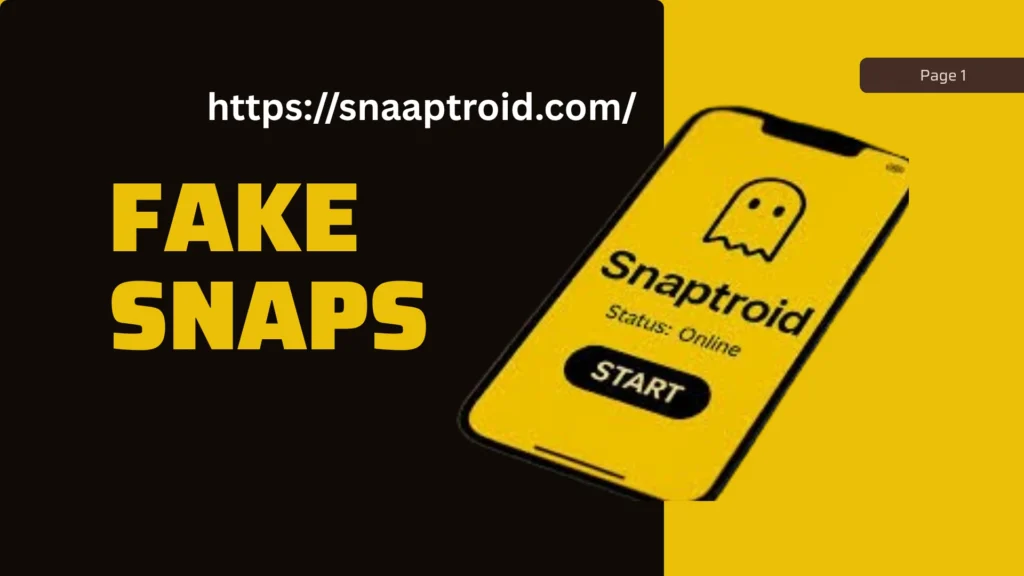Fake Snap 2025
Want to say what’s real or fake on Snapchat?A fake snap can fool your eyes with ease! Learn how snaptroid versions are made, how to spot fake snaps quickly and how to protect your online life from digital deceptions now.

If you’ve ever seen a Snapchat photo or video and thought this looks fake it’s a fake snap which is content intended to trick, deceive or mislead users. Although fake photos on snaptroid may be amusing they can also have serious consequences such as scams, harm to one’s reputation, invasions of privacy and even legal issues. This article provides comprehensive easy-to-understand explanations of fake snaps so you can identify them and be safe.
What is a fake snap?
Any Snapchat picture video or narrative that has been edited, staged or produced with the intention of misleading is considered a fake snap.
Some examples are as follows.
- Edited images that depicted an untrue event.
- Screenshots of fictitious dialogues.
- Manipulated clips or deepfake videos that were presented as authentic.
- Fake accounts that pose as someone else in impersonation snaps.
- When someone tries to mislead viewers about facts, identity or events a photo becomes fake.
Common types of fake snaps
These are the types of fake snaps at snaptroid for PC.
Edited images.
Pictures that have been cropped, retouched or combined with editing software in order to deceive viewers are known as edited images. They frequently alter the original context giving fictitious moments a convincing and authentic appearance.
Create fake screenshots
Photo editors on snaptroid for iOS or phony chat apps are used to create fake screenshots which depict fictitious dialogue or narratives. They are intended to incite conflict or disseminate misleading information.
Account impersonation
These profiles mimic the name image and bio of actual users or companies. Their primary objective is to deceive followers, win people over or con them with phony messages or photos.
AI-generated audio or vide
AI-generated audio or video clips that closely resemble the voices and faces of real people are known as deepfakes. . Deepfakes are frequently used to spread false information or blackmail victims because they can be incredibly convincing.
- Events
Events that have been staged are videos that have been planned to appear authentic or unplanned. To gain viewers’ attention or social media fame creators stage fictitious events such as fights, pranks or accidents.
- Clickbait and false claims.
Snaps with shocking titles or untrue promises are examples of clickbait and false claims. To increase clicks or followers they deceive viewers with fictitious offers, dramatic tales or celebrity rumors.
Why people create fake snaps
Likes and attention:
People fabricate photos to increase their popularity and attract immediate attention. Even if it is false, viral content spreads quickly leading to immediate fame and social validation.
- Pranks:
Although some phony photos are intended only as jokes or for amusement they can quickly go too far. Something amusing to one individual may cause pain or embarrassment to another.
- Reputation attacks:
Fake photos can also be used for political or social manipulation such as dividing people, influencing opinions or disseminating misleading information. They are effective instruments for disinformation and public control.
Knowing motive enables us to assess risk and react appropriately. For example knowing the reason behind someone’s fake snap allows you to react appropriately. Being aware is your best defense against any kind of deception, prank or propaganda.
The risks of fake snaps
There are some risky actions that can be faced when you are using it from any website other then official website.
Emotional harm:
Victims may experience trauma anxiety or shame.
Loss of money:
Identity theft and money theft are two outcomes of scams.
Reputational harm:
Untrue information can harm one’s reputation, relationships or employment.
Implications for the law:
It may be against the law to produce or distribute specific fake content.
Misinformation:
False information can spread swiftly through fake photos damaging communities.
What to do if you see a fake snap
- Don’t distribute it.
- Spreading hurts.
- If it’s safe, take a screenshot or save the evidence for reporting.
- Via the app report Snapchat
How to protect yourself and your friends
- Limit who can send you photos or keep profiles private.
- On all social media accounts create strong one-of-a-kind passwords and turn on 2FA.
- Share only what you want to share because private images can be used to fabricate fakes.
- Get rid of any dubious third-party apps that request your access or login.
Safer alternatives to creating “fake” content
- If you want to be funny or creative, think about these moral choices.
- Mark as parody or satire. To let viewers know it’s not really true.
- Make use of filters and unique effects that don’t mimic actual people or events.
- Instead of pretending to be someone you’re not making up stories and characters.
- Ask anyone who appears in a staged photo for their permission.
- Create educational materials that alert people to the dangers of fakes.
Fake snaps Pros and Cons
Pros
Cons
FAQS
Conclusion
There is fake snap content everywhere.Many of it can spread misleading information and cause harm even though some of it is harmless entertainment. Being vigilant when sharing content, avoiding questionable sources, protecting your accounts and reporting impersonation or scams as soon as you become aware of them is the best defense. Before taking any humorous or fictional pictures get everyones approval. Be smart stay safe and help others by stopping the spread of false images.






